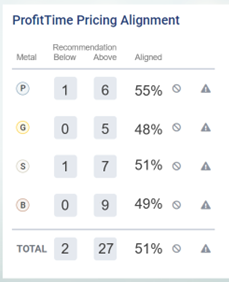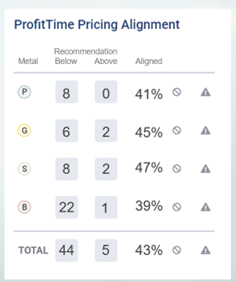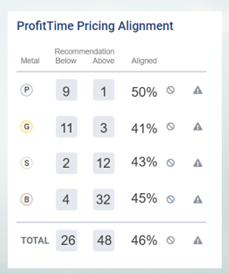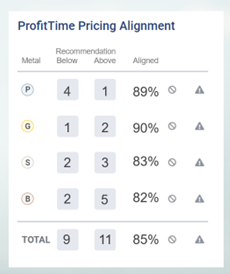ProfitTime GPS in Practice: Who’s Your Used Car Captain?
It’s fair to say that there’s often a gap between the way a used vehicle manager manages a used vehicle department and the way a dealer believes the department  is being managed.
is being managed.
The gap often owes to the reality that dealers, despite their best efforts, often can’t pay extremely close attention to the manager’s day-to-day decision-making. Dealers also haven’t had the right tools to properly measure how right or well a used vehicle manager is steering the used vehicle department. As a result, dealers often can’t tell if a manager’s steering the department on or off their preferred strategic course.
This gap provided the inspiration for the Pricing Alignment tool inside the ProfitTime GPS solution. We envisioned it to be the equivalent of the navigational tools that airplane pilots or ship captains use to know if they’re staying on their charted course or veering away from it.
With the Pricing Alignment Tool, dealers can see their inventories segmented by the solution’s Platinum, Gold, Silver and Bronze investment categories. The tool also shows the vehicles in each category and whether a manager prices them above or below the strategic price range recommendations ProfitTime GPS provides. Note: The system’s pricing recommendations are calibrated to ensure that each vehicle, in each investment class, is priced appropriately to optimize the vehicle’s unique ROI and profit potential.
I’ve been using the Pricing Alignment Tool in my conversations with dealers on an almost-daily basis since it debuted a year ago. I’ve seen first-hand how an individual manager’s beliefs and biases can influence their day-to-day decision-making and, in many cases, cause them to steer the used vehicle department away from the dealer’s preferred strategic course.
I’m now asking dealers: “Who’s your used vehicle captain and how well are they steering your ship?” Of course, I turn to the Pricing Alignment Tool for answers. Here’s a quick look at the four categories of used car captains I typically find:
Captain 1: A Gross-Getter
The graphic on the right offers a representative view of the first type of used vehicle captain—an individual for whom maximum gross profit matters most,  often above all else. You can easily see the evidence of the manager’s emphasis on gross profit. Across every ProfitTime GPS investment category, the manager’s priced vehicles above the solution’s pricing recommendations. The manager’s overall 51 percent pricing alignment suggests he/she/they agree with the recommendations at least some of the time. In the end, though, the desire to maximize gross profit serves as the manager’s effective default pricing decision.
often above all else. You can easily see the evidence of the manager’s emphasis on gross profit. Across every ProfitTime GPS investment category, the manager’s priced vehicles above the solution’s pricing recommendations. The manager’s overall 51 percent pricing alignment suggests he/she/they agree with the recommendations at least some of the time. In the end, though, the desire to maximize gross profit serves as the manager’s effective default pricing decision.
The upshot: The manager’s dealer may be perfectly satisfied with the gross-minded decision-making. I would submit, however, that the manager’s emphasis on gross profit likely costs the dealer some sales volume and, potentially, less gross overall as the vehicles wait to find buyers willing to pay the gross the manager believes they should.
Captain 2: A Volume Gunner
You can see this manager’s gunning for sales volume by the sheer number of vehicles priced below ProfitTime GPS recommendations. It’s also true that this  manager apparently has less interest or trust in the recommendations themselves, as evidenced by an overall alignment of 43 percent.
manager apparently has less interest or trust in the recommendations themselves, as evidenced by an overall alignment of 43 percent.
The manager’s volume-oriented pricing priority may be perfectly acceptable to the dealer, especially if it’s someone who believes you make more when you sell more.
But I would submit that a volume-focused pricing strategy ultimately means that the dealership is losing out on gross profit opportunities, especially with the Platinum and Gold vehicles that, thanks to the data science behind ProfitTime GPS’ pricing recommendations, we now know have the appeal and capability of delivering the highest ROI and gross profit potential.
Captain 3: A Great Pretender
This type of used vehicle manager is, by far, the most common that I see when I work with dealers to drive better outcomes for their used vehicle  departments. In the graphic at right, you can see the manager is pricing their best used vehicle investments, the Platinum and Gold cars, below ProfitTime GPS pricing recommendations. Meanwhile, the manager is pricing the store’s worst used vehicle investments, the Silver and Bronze vehicles, above the pricing recommendations.
departments. In the graphic at right, you can see the manager is pricing their best used vehicle investments, the Platinum and Gold cars, below ProfitTime GPS pricing recommendations. Meanwhile, the manager is pricing the store’s worst used vehicle investments, the Silver and Bronze vehicles, above the pricing recommendations.
To me, this pricing profile is potentially the most troubling. It suggests that the manager doesn’t want to face the music on the worst cars, and is cheap-selling the dealer’s best used vehicle investments to drive volume. Ultimately, this manager’s a Great Pretender—pretending that the gross on Platinum and Gold vehicles isn’t available, and pretending that they’ll get all the gross on Silver and Bronze cars, which likely wasn’t available on Day 1.
Captain 4: An On-Course Operator
I love it when I see a used vehicle manager with the type of pricing profile you see on the right. Note the overall 85 percent alignment. The manager has a  fair amount of faith and trust in the ProfitTime GPS pricing recommendations but isn’t accepting them all the time. Why? Because the manager understands that, no matter how good the data science, there are times when a manager’s discretion or specific knowledge about a vehicle can suggest a better opportunity. Across the investment categories, you can see a mix of vehicles priced above and below recommendations.
fair amount of faith and trust in the ProfitTime GPS pricing recommendations but isn’t accepting them all the time. Why? Because the manager understands that, no matter how good the data science, there are times when a manager’s discretion or specific knowledge about a vehicle can suggest a better opportunity. Across the investment categories, you can see a mix of vehicles priced above and below recommendations.
When I see this profile, I give dealers, and the manager, solid props. I view the data in the Pricing Alignment Tool as strong evidence that, on a car-by-car basis, the manager is trying to do the right thing, and achieve the optimal outcome for the dealer’s investment. In other words, the managers are steering the ship on course, as they should. I would also note that managers with this type of pricing profile also tend to have higher gross profit and sales volume averages than managers with less-balanced approaches to the way they manage used vehicle investments.
In today’s market environment, where there are plenty of cross-currents including fluctuating retail demand, wholesale values and affordability, I think it’s useful for every dealer to ask the question: Who’s my used vehicle captain and how are they steering my used vehicle department?
If my experience is any indication, dealers will be surprised when they see the answer for the first time.
